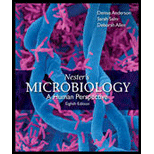
Concept explainers
How is preservation different from pasteurization?
To review:
The difference between the preservation and the pasteurization.
Introduction:
Microorganisms are found in every possible place and environmental conditionals like air, water, hot springs, deep thermal vents, and in saline conditions. They are microscopic and can grow rapidly. However, it becomes crucial in some cases, such as in food, medicines, and in open wounds where these microbes need to get rid off in order to eliminate the chances of infections and diseases. Thus, several methods of sterilization and preventive are available so as to destroy or prevent their spread.
Explanation of Solution
Various measures including physical, chemical, or a combination of both are employed to control or prevent the microbial growth at the unwanted places. The physical methods comprise washing, irradiation, filtration, and heat treatment, whereas the chemical methods include the use of various chemicals, disinfectants, and other drugs to kill the microbes and thus, prevent their growth. The main processes followed to control the microbial growth are:sterilization, disinfection, preservation, and pasteurization.
The main difference between the preservation and the pasteurization is tabulated as follows:
| Preservation | Pasteurization |
| (1) It refers to the process of delaying the spoilage of the products which can get decay fast (perishable items) such as vegetables. | (1) This refers to the heat treatment for a short period of time without changing the properties of the materials as it increases the shelf-life of the product. |
| (2) This can be done by storing the materials at cold temperatures or by adding preservatives. | (2) The most used pasteurization is high-temperature short-time (HTST) for milk. Other than this, ultra-high-temperature (UHT) pasteurization is also used for juices and wine. |
| (3) They have the bacteriostatic effect, that is, they inhibit the microbial growth without killing them. | (3) In this method, most of the microbes responsible for spoilage are killed and are reduced in number too. |
Therefore, the methods of preservation and pasteurization are used to control the spoilage of food material due to the growth of microbes. Preservation includes inhibition of their growth without killing them, whereas pasteurization is the killing of the microbes by a heat treatment for a short time.
Want to see more full solutions like this?
Chapter 5 Solutions
Nester's Microbiology: A Human Perspective
- What is the structure and function of Eukaryotic cells, including their organelles? How are Eukaryotic cells different than Prokaryotic cells, in terms of evolution which form of the cell might have came first? How do Eukaryotic cells become malignant (cancerous)?arrow_forwardWhat are the roles of DNA and proteins inside of the cell? What are the building blocks or molecular components of the DNA and proteins? How are proteins produced within the cell? What connection is there between DNA, proteins, and the cell cycle? What is the relationship between DNA, proteins, and Cancer?arrow_forwardWhy cells go through various types of cell division and how eukaryotic cells control cell growth through the cell cycle control system?arrow_forward
- In one paragraph show how atoms and they're structure are related to the structure of dna and proteins. Talk about what atoms are. what they're made of, why chemical bonding is important to DNA?arrow_forwardWhat are the structure and properties of atoms and chemical bonds (especially how they relate to DNA and proteins).arrow_forwardThe Sentinel Cell: Nature’s Answer to Cancer?arrow_forward
- Molecular Biology Question You are working to characterize a novel protein in mice. Analysis shows that high levels of the primary transcript that codes for this protein are found in tissue from the brain, muscle, liver, and pancreas. However, an antibody that recognizes the C-terminal portion of the protein indicates that the protein is present in brain, muscle, and liver, but not in the pancreas. What is the most likely explanation for this result?arrow_forwardMolecular Biology Explain/discuss how “slow stop” and “quick/fast stop” mutants wereused to identify different protein involved in DNA replication in E. coli.arrow_forwardMolecular Biology Question A gene that codes for a protein was removed from a eukaryotic cell and inserted into a prokaryotic cell. Although the gene was successfully transcribed and translated, it produced a different protein than it produced in the eukaryotic cell. What is the most likely explanation?arrow_forward
 Principles Of Radiographic Imaging: An Art And A ...Health & NutritionISBN:9781337711067Author:Richard R. Carlton, Arlene M. Adler, Vesna BalacPublisher:Cengage LearningEssentials Health Info Management Principles/Prac...Health & NutritionISBN:9780357191651Author:BowiePublisher:Cengage
Principles Of Radiographic Imaging: An Art And A ...Health & NutritionISBN:9781337711067Author:Richard R. Carlton, Arlene M. Adler, Vesna BalacPublisher:Cengage LearningEssentials Health Info Management Principles/Prac...Health & NutritionISBN:9780357191651Author:BowiePublisher:Cengage





